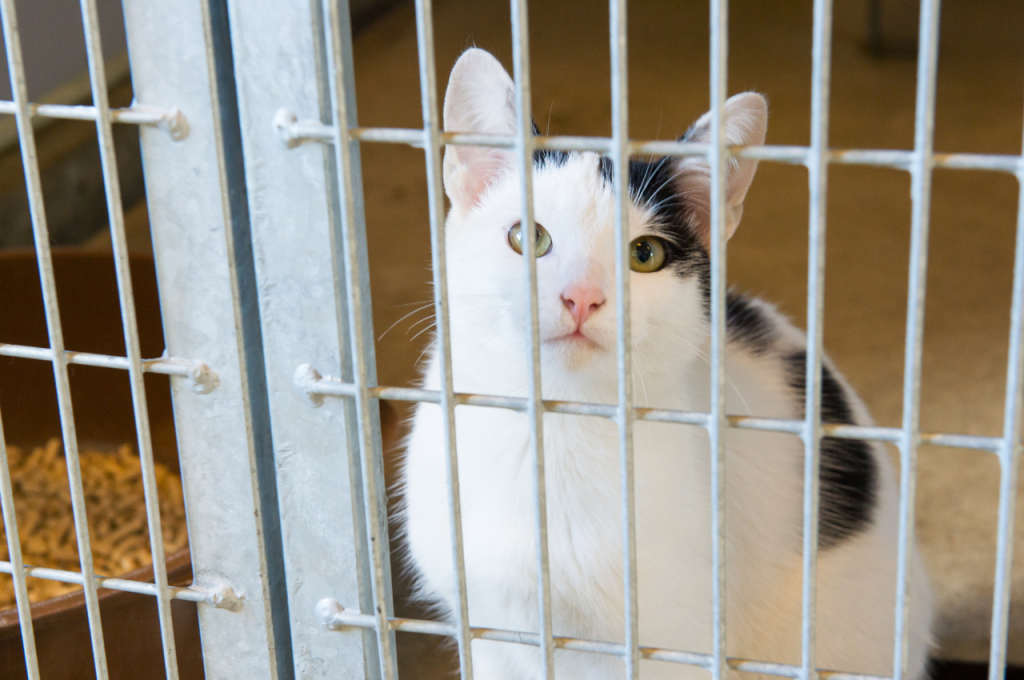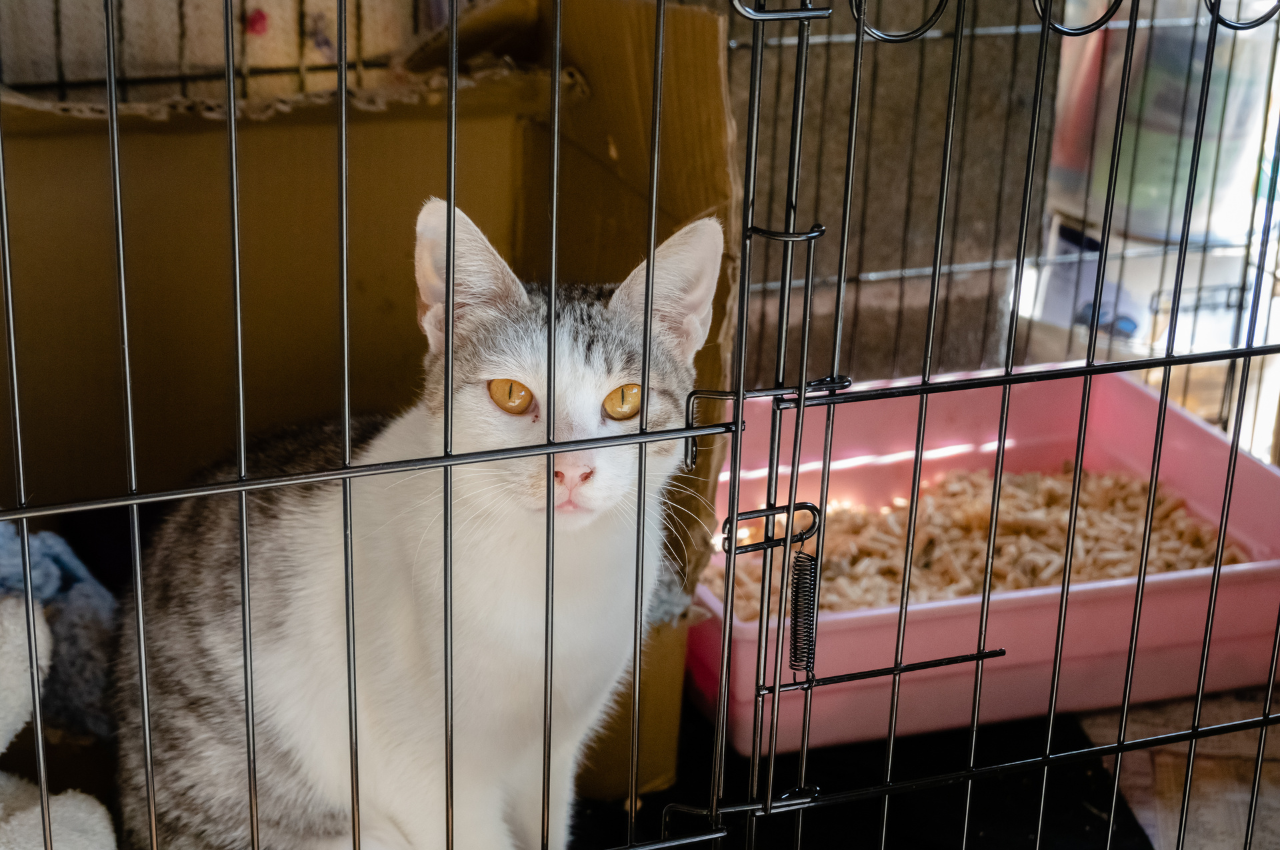To make a cat comfortable in a cage, provide a cozy bed and familiar items like toys or blankets. Additionally, ensure the cage is spacious, well-ventilated, and clean.
Creating a comfortable environment for a cat in a cage is essential for its well-being and overall happiness. Whether it’s for transportation, vet visits, or temporary confinement, ensuring that the cat feels secure and at ease is crucial. Cats are naturally curious and independent animals, so being confined in a cage can be stressful for them. However, with the right approach, you can make their time in the cage more comfortable and less distressing. By following a few simple steps, you can help your feline friend feel safe and content while in a cage.
Introduction to Feline Comfort in Enclosed Spaces
Cats, known for their independent nature, can sometimes find themselves in situations where they need to be confined to a cage or carrier. Whether it’s for travel, veterinary visits, or recovery from illness, it’s important to ensure that our feline friends remain comfortable and stress-free in these enclosed spaces. By understanding the challenges and implementing strategies to create a soothing environment, we can help our cats feel at ease and secure in their temporary homes.

The Importance of a Comfortable Environment for Cats
Creating a comfortable environment for cats in enclosed spaces is crucial for their well-being. Adequate space, familiar scents, and cozy bedding can help reduce stress and anxiety, ensuring that the cat feels safe and secure. By providing a conducive environment, we can promote relaxation and minimize the negative impact of confinement on the cat’s mental and physical health.
Common Challenges of Caging Felines
When cats are confined to a cage, they may experience anxiety, restlessness, and discomfort. It’s essential to address these challenges by offering mental stimulation, opportunities for movement, and access to food and water. Understanding the common issues that arise when felines are caged allows us to implement strategies to mitigate these challenges, promoting a more positive experience for our furry companions.
Selecting The Right Cage
When it comes to making your cat comfortable in a cage, selecting the right cage is crucial. The right cage can provide a sense of security and comfort for your feline friend, making their time in the cage as stress-free as possible.
Size and Space Considerations
Size matters when it comes to selecting a cage for your cat. It’s important to choose a cage that provides enough space for your cat to move around comfortably. The cage should be tall enough for your cat to stand up without hunching and long enough for them to stretch out. Adequate space promotes a sense of freedom and reduces feelings of confinement.
Material and Design Features
Consider the material and design features of the cage when making your selection. Look for a cage made of durable, non-toxic materials that are easy to clean. A secure door and well-ventilated sides are also important design features to ensure your cat’s safety and comfort. Adequate ventilation helps to regulate temperature and prevents your cat from feeling too confined.
Essential Cage Accessories
When setting up a cage for your cat, it’s essential to include the right accessories to ensure their comfort and well-being. From choosing the right bedding to providing toys for mental stimulation, these accessories play a crucial role in making the cage a comfortable and enriching environment for your feline friend.
Choosing The Right Bedding
Bedding is a critical component of a cat’s cage, providing a soft and comfortable surface for them to rest on. Opt for soft, cushioned bedding that is easy to clean and maintain. Consider materials like fleece or plush fabric to create a cozy sleeping area for your cat.
Toys and Entertainment for Mental Stimulation
Mental stimulation is vital for a cat’s well-being, especially when they are confined to a cage. Provide interactive toys that encourage play and exploration. Feather wands, treat-dispensing toys, and catnip-filled pillows are excellent options to keep your cat engaged and entertained.
Creating a Soothing Atmosphere
To make a cat comfortable in a cage, creating a soothing atmosphere is key. Provide a soft and cozy bed, toys, and a litter box, and ensure the cage is located in a quiet and dimly lit area to reduce stress. Additionally, covering the cage with a blanket can create a den-like environment for added comfort.
The Role of Scent in Feline Comfort
Cats have a strong sense of smell, and their comfort level in a cage can be heavily influenced by scent. When creating a soothing atmosphere for your furry friend, it’s important to pay attention to the smells in the area. Firstly, make sure the cage is clean and free of any unpleasant odors. Additionally, consider incorporating scents that your cat may find calming, such as lavender or chamomile. However, it’s important to note that some cats may be sensitive to strong smells, so it’s best to introduce new scents gradually and monitor your cat’s reaction.

Using Calming Pheromones and Sprays
Calming pheromones and sprays are a great way to create a relaxing environment for your cat. These products mimic the natural pheromones that cats produce and can help to reduce anxiety and stress. Some popular options include Feliway diffusers and sprays, which release synthetic pheromones that can help your cat feel more comfortable in their cage. However, it’s important to note that these products may not work for all cats and should be used in conjunction with other methods to create a soothing atmosphere.
When creating a soothing atmosphere for your cat in their cage, remember to pay attention to scent and consider using calming pheromones and sprays. These simple steps can help your cat feel more comfortable and relaxed, making their time in the cage more enjoyable.
Feeding and Hydration inside The Cage
Cats can feel anxious in cages, especially during feeding times. Providing appropriate food and water placement, as well as maintaining cleanliness and hygiene, are crucial for their comfort.
Appropriate Food and Water Placement
- Place food and water bowls away from the litter box.
- Ensure bowls are secure and won’t tip over.
- Offer fresh water daily.
Maintaining Cleanliness and Hygiene
- Clean food and water bowls regularly.
- Remove any uneaten food promptly.
- Provide fresh water twice a day.
Training Your Cat for The Cage
Help your feline friend acclimate to their cage by gradually introducing them to the space with positive reinforcement and comfort items. Create a cozy environment with familiar scents and toys to ease their transition and reduce stress levels.
If you have a cat, and you need to travel, take your cat to the vet, or even move to a new home, you may need to use a cat cage to transport them safely. However, cats are known for their independence and may not take kindly to being confined. This is why it’s essential to train your cat for the cage. Here are some steps to follow to make the process as smooth as possible.
Gradual Introduction to The Cage
Cats are naturally curious animals, so it’s essential to let them explore the cage on their own terms. Start by placing the cage in a quiet area of the house, with the door open. Put some of your cat’s favorite toys or treats inside the cage to encourage them to investigate. Allow your cat to come and go from the cage as they please, but never force them inside. Once your cat is comfortable going in and out of the cage, you can start closing the door for short periods while you’re home.
Positive Reinforcement Techniques
Positive reinforcement is a powerful tool when it comes to training your cat for the cage. You can use treats, praise, and affection to reward your cat for good behavior. For example, every time your cat enters the cage willingly, give them a treat or a pat on the head. You can also try feeding your cat their meals inside the cage, so they start to associate it with positive experiences. With time and patience, your cat will learn that the cage is a safe and comfortable place to be.
In conclusion, training your cat for the cage takes time and patience, but it’s worth it in the end. Gradual introduction and positive reinforcement techniques will help your cat feel comfortable and safe in the cage, making travel and vet visits much less stressful for both you and your furry friend.
Health and Safety Precautions
Ensuring the health and safety of your cat in a cage is paramount to their well-being. By following some essential guidelines, you can create a safe environment for your feline friend.
Regular Health Checks and Monitoring
- Schedule routine vet visits for your cat.
- Monitor your cat’s behavior and appetite daily.
- Check for any signs of illness or distress promptly.
Emergency Preparedness and Escape Routes
- Prepare an emergency kit for your cat.
- Identify escape routes in case of emergencies.
- Keep contact information for a vet handy.
Special Considerations for Long-term Confinement
When caring for a cat in long-term confinement, there are key aspects to focus on to ensure their well-being and comfort.

Managing Stress and Anxiety
Cats can experience stress and anxiety in cages. Provide cozy bedding and familiar toys.
- Engage in interactive play sessions daily to alleviate stress.
- Use calming pheromone diffusers to create a soothing environment.
Ensuring Physical Exercise and Movement
Encourage movement to prevent muscle stiffness and boredom.
- Set up climbing structures and scratching posts for physical activity.
- Rotate toys regularly to keep them mentally stimulated.
Conclusion
Providing a cat with a comfortable environment in a cage involves creating a cozy space with familiar items, offering regular interaction and playtime, and ensuring essential needs like food, water, and cleanliness are met. By following these tips, you can help your feline companion feel secure and content.
